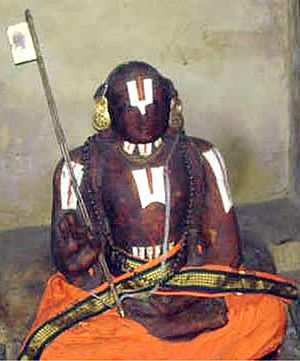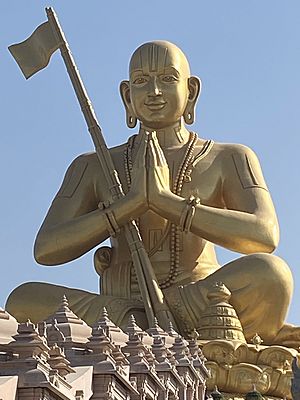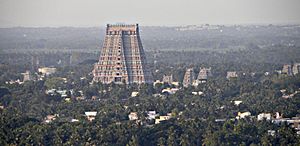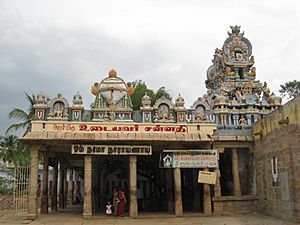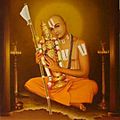Ramanuja facts for kids
Quick facts for kids Rāmānujācārya |
|
|---|---|
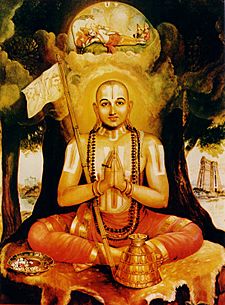 |
|
| Birth Date | April 25, 1017 CE Sriperumbudur, Chola Empire (modern day Tamil Nadu, India) |
| Died on | c. 1137 CE (aged 120) Srirangam, Chola Empire (modern day Tamil Nadu, India) |
| Birth name | Iḷaiyāḻvār |
| Philosophy | Vishishtadvaita |
| Titles/honors | Emberumānār, Udaiyavar, Yatirāja (king of sannyasis) |
Ramanuja, also known as Ramanujacharya, was an important Indian Hindu thinker and teacher. He lived from about 1017 CE to 1137 CE. He is famous for his ideas within the Sri Vaishnavism tradition.
Ramanuja's teachings greatly influenced the Bhakti movement. This movement focused on loving devotion to God. He taught a special kind of philosophy called Vishishtadvaita. This means "qualified non-dualism." It teaches that our souls are part of God but also unique.
Contents
Ramanuja's Life Story
Ramanuja was born in a Brahmin family in a village called Sriperumbudur. This village is in modern-day Tamil Nadu, India. His followers wrote many stories about his life. These stories are called hagiographies.
He was born to Kānthimathi and Asuri Keshava Somayāji. Most stories say he lived for 120 years, from 1017 CE to 1137 CE. However, some modern experts think he might have lived from 1077 CE to 1157 CE.
Ramanuja got married and moved to Kanchipuram. There, he studied with a teacher named Yādava Prakāśa. Ramanuja and his teacher often disagreed about how to understand ancient texts called the Upanishads. Because of these differences, they eventually went their separate ways. Ramanuja then continued his studies on his own.
He wanted to meet another famous scholar, Yamunāchārya. But Yamunāchārya passed away before they could meet. Some stories say that Yamunāchārya's body miraculously rose and named Ramanuja as the new leader. Later, Ramanuja became a Hindu monk. He gave up his married life to focus on his spiritual path.
Ramanuja became a priest at the Varadharāja Perumal temple in Kanchipuram. He began to teach that true freedom, or moksha, comes from devotion to a personal God, especially Vishnu.
Early Challenges
When Ramanuja and his teacher Yādava Prakāśa went their separate ways, Ramanuja became very devoted to the Varadaraja Perumal temple in Kanchipuram. His teachings and fame grew.
Yamunāchārya, a respected Vaishnavite leader, heard about Ramanuja. He wanted Ramanuja to take over his work at the Ranganathasamy temple in Srirangam. Yamunāchārya sent his disciple, Sri Mahapurna, to bring Ramanuja.
Ramanuja was excited to meet Yamunāchārya. But when they arrived in Srirangam, they learned that Yamunāchārya had passed away. Ramanuja was heartbroken and returned to Kanchi. Later, the leaders at Srirangam realized they needed someone like Yamunāchārya to explain the ancient texts. So, they asked Mahapurna to invite Ramanuja again.
In Kanchi, Ramanuja met Kanchipurna, another devotee. Ramanuja wanted Kanchipurna to be his teacher. But Kanchipurna politely refused because they were from different social groups. He told Ramanuja to find a more suitable teacher. Later, Kanchipurna told Ramanuja that Lord Varadaraja wanted him to go to Srirangam and find comfort with Sri Mahapurna.
Mahapurna went to invite Ramanuja to Srirangam again. On his way, he stopped at Maduranthakam. By chance, Ramanuja, who was also on his way to Srirangam, arrived at the same place. They were both happy to see each other.
Ramanuja asked Mahapurna to quickly make him a part of the Vaishnavite order. Mahapurna agreed right away. Ramanuja received the Panchasamskaras, which are five important ceremonies. This was a key step in his spiritual journey.
Facing Difficulties
Some stories say that a Chola king, Kulothunga II, disliked Sri Vaishnavism. He was even called "Kirimikanta Chola," meaning "worm-necked Chola," because he supposedly had a neck illness.
Ramanuja's disciple, Sri Koorathazhwan, convinced Ramanuja to leave the Chola kingdom. Ramanuja went to the Hoysala kingdom for 14 years. There, he helped a Jain king, Bitti Deva, by miraculously healing his daughter. The king then became a Hindu and changed his name to Vishnuvardhana.
King Vishnuvardhana helped Ramanuja build a temple for Lord Thirunarayanaswamy in Melukote. Ramanuja later returned to Tamil Nadu after the king who disliked him passed away.
Social Reforms
Ramanuja believed in equality. He saw that the Sri Vaishnavite community already welcomed people from different social groups. He strongly spoke out against unfair treatment based on social status.
He helped people who were considered "untouchables" to join the Sri Vaishnava Bhakti Movement. He taught them ancient hymns and encouraged them to seek spiritual understanding. He called these groups Tirukulattar, meaning "of noble descent" in Tamil. He even helped them enter the temple in Melukote.
Ramanuja's open-minded views also led to changes in temple rituals at Srirangam. He allowed non-Brahmin people to take part in Vaishnava worship. These changes improved the social standing of many groups, especially weavers. After Ramanuja's time, the Sri Vaishnava community divided into two groups, the Vadakalai and Thenkalai, partly over these issues.
Attempts on Ramanuja's Life
There were a few times when people tried to harm Ramanuja.
- When he was studying with Yadava Prakasa, his teacher became jealous. Yadava Prakasa tried to get rid of Ramanuja during a trip to the Ganges River. Ramanuja's cousin, Govinda, found out about the plan and warned him. Ramanuja then escaped with the help of an elderly hunter couple. Later, Yadava Prakasa realized his mistake and became Ramanuja's student.
- Another attempt happened when Ramanuja was about to take charge of the temple in Srirangam. The head priest of the Ranganathaswamy Temple, Srirangam disliked Ramanuja. He invited Ramanuja to his house and planned to poison his food. However, the priest's wife saw a special glow around Ramanuja and confessed her husband's plan. The priest tried again by poisoning the temple's holy water (Theertham). But when Ramanuja drank it, he danced with joy instead of dying. The priest was shocked and realized his error, then bowed to Ramanuja.
Ramanuja's Writings
Ramanuja is believed to have written nine important texts in Sanskrit. These include:
- Vedārthasangraha (a summary of the meaning of the Vedas)
- Sri Bhāshya (a commentary on the Brahma Sutras)
- Bhagavad Gita Bhāshya (a commentary on the Bhagavad Gita)
He also wrote shorter works like Vedāntadipa, Vedāntasāra, Gadya Trayam, and Nitya Grantham. Some experts have questioned if all these works were truly written by him. However, his three largest works are widely accepted as his.
Ramanuja's Philosophy
Ramanuja's main philosophy is called Vishishtadvaita, or "qualified monism." It is one of the three main schools of Vedānta in Hinduism. The other two are Advaita (absolute monism) by Ādi Shankara and Dvaita (dualism) by Madhvāchārya.
Understanding Knowledge
Ramanuja believed that what we see and learn through our senses is real and trustworthy. Even in dreams, he thought we are experiencing something real. Mistakes happen when our perception or thinking is confused.
He also believed that ancient scriptures are a very important source of knowledge. They help us understand things we cannot see or figure out on our own, like the nature of God (Brahman). Ramanuja taught that true knowledge, or jñāna, comes from directly experiencing something. He also said that deep devotion, or bhakti, is a form of knowledge. When bhakti becomes very strong, it helps us understand God's true nature.
Finding Spiritual Freedom
For Ramanuja, the greatest goal is to understand our true selves and the true nature of God (Brahman). Moksha, or spiritual freedom, is about the joy of thinking about God's perfection. This joy comes from devotion, praise, worship, and always focusing on God's greatness.
Ramanuja taught that just knowing about God is not enough for freedom. We need to practice bhakti yoga, which is the path of devotion and worship. He believed that freedom is not just escaping rebirth. It is the happiness of being devoted to God. In return, God will give us grace, which helps us achieve this freedom.
Differences with Shankara
Ramanuja disagreed with Shankara's ideas in a few ways.
- Ramanuja believed that God (Brahman) has different qualities and is not just a single, undifferentiated consciousness.
- He thought Shankara's idea of a "God without qualities" was wrong.
- He also believed that our past actions (karma), not just illusion, cause our ignorance.
- Ramanuja found several problems with Shankara's ideas of Avidya (Ignorance) and Maya (Illusion).
Ramanuja's Impact
Ramanuja is seen as a very important teacher for Sri Vaishnavism. Many people call him one of the most influential thinkers in devotional Hinduism. He gave the idea of bhakti (devotion) a strong intellectual foundation. His work made bhakti a major force in different Hindu traditions.
Experts today compare Ramanuja's importance in Hinduism to that of Thomas Aquinas in Western Christianity.
Ramanuja made changes to the Srirangam Ranganathaswamy temple complex. He traveled all over India, spreading his teachings and organizing his followers. The Srirangam temple became a strong center for his ideas. It was there that he wrote his famous philosophy book, Sri Bhashyam.
Ramanuja not only developed new ideas but also set up a network of temples for the worship of Vishnu and Lakshmi. He created study centers for his philosophy in the 11th and 12th centuries. These centers influenced many poet-saints of the Bhakti movement for generations. Some local stories say that his visits and discussions led Jains and Buddhists in the Mysore and Deccan regions to become Vaishnavites.
Ramanuja's birthplace near Chennai has a temple and an active school that teaches his philosophy. His ideas continue to inspire people in southern, northern, and eastern India. His monasteries and temple traditions are still active in major Vaishnava centers. These include the Ranganātha temple in Srirangam, and the Venkateswara Temple, Tirumala in Tirupati.
A large statue called the Statue of Equality in Hyderabad is dedicated to Ramanuja. It was opened by the Indian Prime Minister in 2022.
Other Names for Ramanuja
Ramanuja was known by many names, showing how much he was respected:
- Śrī Rāmānujāchārya
- Udaiyavar
- Ethirājar (Yatirāja, meaning king of monks)
- Bhashyakara (meaning commentator)
- Godāgrajar
- Thiruppavai Jeeyar
- Emberumānār
- Lakshmana Muni
Here are some specific names given by different people:
- 'Ilayazhwar' by Periya Thirumalai Nambi
- 'Boodha Puriser' by Sriperumbudur Adikesava Perumal
- 'Am Mudalvan Evan' by Yamunāchārya
- 'Ethirajar' and 'Ramanuja Muni' by Kanchi Perarulala Perumal
- 'Udayavar' by Srirangam Periya Perumal
- 'Emperumanar' by Tirukozhtiyur Nambi
- 'Tiruppavai Jeeyar' by Periya Nambi
- 'Lakshmana Muni' by Tiruvaranga Perumal Arayar
- 'Sadagopan Ponnadi' by Tirumalaiyandan
- 'Sri Bashyakarar' by Kalaimagal
- 'Desi Kendiran' by Tirupathi Thiruvenkatamudayan
- 'Koil Annan' by Srivilliputhur Kothai Nachiyar
Images for kids
See also
 In Spanish: Rāmānuja Āchārya para niños
In Spanish: Rāmānuja Āchārya para niños
- Adi Shankarar
- Ramanujacharya
- Ramanujar
- Hindu philosophy
- Subala Upanishad – a minor Upanishad repeatedly cited by Ramanuja, and influential to his ideas
- Yoga (philosophy)
- Vishnuvardhana



